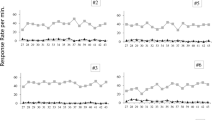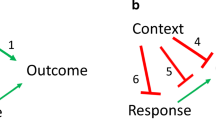Abstract
The acquisition and long-term retention of overt response patterns were recorded during compound conditioning with mice. A 10-sec light + tone compound was terminated by a food pellet unconditioned stimulus, with the subject’s relative location tracked by computer during control and stimulus intervals. Compound conditioning elicited a variety of response patterns, including uniformly brief orienting responses to the localized light and tone intermixed with variable duration responses to the food cup. The response patterns resulted in both a complementary inhibition and a sequential dependence between responses that remained relatively stable for 120 to 180 days following initial conditioning. The compound conditioned stimuli elicited a molecular or within-trial “overshadowing” effect, with food cup responses differentially dependent upon the prior occurrence of orienting responses to either the light or tone. Both the concurrent inhibition and sequential elicitation of responses in Pavlovian conditioning are consistent with previous analyses of response patterns in experimental schedules.
Similar content being viewed by others
References
ANOKHIN, P.K. 1958. The role of the orienting exploratory reflex in the formation of the conditioned reflex. In L.G. Voronin, A.N. Leontiev, A.R. Luria, E.N. Sokolov, & O.S. Vinogradova (Eds.), Orienting reflex and exploratory behavior. Moscow: Academy of Pedagogical Sciences.
BAUERMEISTER, J.J., & SCHAEFFER, R.W. 1974. Reinforcement relation: Reversibility within daily experimental sessions. Bulletin of the Psychonomic Society, 3, 206–208.
BEST, M.R., DOMJAN, M., & HASKINS, W.L. 1978. Long term retention of flavor familiarization: Effects of number and amount of prior exposures. Behavioral Biology, 23, 95–99.
BOLLES, R.C. 1960. Grooming behavior in the rat. Journal of Comparative and Physiological Psychology, 53, 306–310.
BOLLES, R.C. 1967. Theory of motivation. New York: Harper & Row.
BRADY, J.V. 1971. Emotion revisited. Journal of Psychiatric Research, 8, 363–385.
BRADY, J.V., & HUNT, H.F. 1955. An experimental approach to the analysis of emotional behavior. Journal of Psychology, 40, 313–325.
BYKOV, V.D. 1958. On the dynamics of the orienting-exploratory reaction during the formation of positive and inhibitory conditioned reflexes and their alterations. In L.G. Voronin, A.N. Leontiev, A.R. Luria, E.N. Sokolov, & O.S. Vinogradova (Eds.), Orienting reflex and exploratory behavior. Moscow: Academy of Pedagogical Sciences.
BRUSH, F.R. 1971. Retention of aversively motivated behavior. In F.R. Brush (Ed.), Aversive conditioning and learning. New York: Academic Press.
CAMPBELL, B.A. 1967. Developmental studies of learning and motivation infra-primate mammals. In H.W. Stevenson, E.H. Hess, & H.L. Rheingold (Eds.), Early behavior: Comparative and developmental approaches. New York: John Wiley.
CAMPBELL, B.A., & CAMPBELL, E.H. 1962. Retention and extinction of learned fear in infant and adult rats. Journal of Comparative and Physiological Psychology, 55, 1–8.
CAMPBELL, B.A., JAYNES, J.R., & MISANIN, J. 1968. Retention of a light-dark discrimination in rats of different ages. Journal of Comparative and Physiological Psychology, 66, 467–472.
CAMPBELL, B.A., & SPEAR, N.E. 1972. Ontogeny of memory. Psychological Review, 79, 215–236.
DOMJAN, M. 1977. Attenuation and enhancement of neophobia for edible substances. In L.M. Barker, M.R. Best, & M. Domjan (Eds.), Learning mechanisms in food selection. Waco, Texas: Baylor University Press.
GANT, W. H. 1965. Pavlov’s systems. In B.B. Wolman (Ed.), Scientific psychology. New York: Basic Books.
GANT, W.H. 1966. Conditioned or conditional, reflex or response? Conditional Reflex, 1, 69–73.
GLEITMAN, H. 1971. Forgetting of long-term memories in animals. In W.K. Honig & P.H.R. James (Eds.), Animal memory. New York: Academic Press.
GLEITMAN, H., & HOLMES, P.A. 1967. Retention of incompletely learned Cer in rats. Psychon om ic Science, 7, 19–20.
HENTON, W.W. 1972. Avoidance response rates during a prefood stimulus in monkeys. Journal of the Experimental A nalysis of Behavior, 17, 269–275.
HENTON, W.W., & BRADY, J.V. 1970. Operant acceleration during a pre-food stimulus. Journal of the Experimental A nalysis of Behavior, 13, 205–211.
HENTON, W.W., & IVERSEN, I.H. 1978. Classical conditioning and operant conditioning: A response pattern analysis. New York: Springer-Verlag.
HENTON, W.W., & SPOHN, W.D. 1980. Classical conditioning with compound unconditioned stimuli. The Psychological Record, 30, 47–60.
HOLLAND, P.C. 1977. Conditioned stimulus as a determinant of the form of the Pavlovian conditioned response. Journal of Experimental Psychology: Animal Behavior Processes, 3, 77–104.
IVERSEN, I.H. 1975. Concurrent responses during multiple schedules in rats. Scandanavian Journal of Psychology, 16, 49–54.
IVERSEN, I.H. 1976. Interactions between reinforced responses and collateral responses. The Psychological Record, 26, 399–413.
JENKINS, H.M., BARRERA, F.J., IRELAND, C., & WOODSIDE, B. 1978. Signal centered action patterns of dogs in appetitive classical conditioning. Learning and Motivation, 9, 272–296.
KAMIN, L.J. 1968. Attention-like processes in classical conditioning. In M.R. Jones (Ed.), Miami symposium on the prediction of behavior: Aversive stimulation. Miami: University of Miami Press.
KAMIN, L.J. 1969. Predictability, surprise, attention, and conditioning. In R. Church & B.A. Campbell (Eds.), Punishment and aversive behavior. New York: Appleton-Century-Crofts.
KANTOR, J.R. 1959. Interbehavioralpsychology. Bloomington, Indiana: Principia Press.
KONORSKI, J. 1967. Integrative activity of the brain. Chicago: University of Chicago Press.
KONORSKI, J. 1972. Some ideas concerning physiological mechanisms of so-called internal inhibition. In R.A. Boakes & M.S. Halliday (Eds.), Inhibition and learning. New York: Academic Press.
MOROSS, G.G., & KAUFMAN, G.I. 1976. Activity monitor for small animals. Physiology and Behavior, 16, 493–495.
PAVLOV, I.P. 1927. Conditioned reflexes. London: Oxford University Press.
PREMACK, D. 1965. Reinforcement theory. In D. Levine (Ed.), Nebraska symposium on motivation. Lincoln: University of Nebraska Press.
RAY, R.D. 1977. Psychological experiments as interbehavioral systems: A case study from the Soviet Union. The Psychological Record, 27, 279–306.
RAY, R.D., & BROWN, D.A. 1975. A systems approach to science. The Psychological Record, 25, 459–478.
RAY, R.D., & BROWN, D.A. 1976. The behavioral specificity of stimulation: A systems approach to procedural distinctions of classical and instrumental conditioning. Pavlovian Journal of Biological Science, 11, 3–23.
RESCORLA, R.A., & WAGNER, A.R. 1972. A theory of Pavlovian conditioning: Variations in the effectiveness of reinforcement and nonrenforcement. In A.H. Black & W.F. Prokasy (Eds.), Classical conditioning II. New York: Appleton-Century-Crofts.
SCHAEFFER, R.W. 1965. The reinforcement relation as a function of instrumental response base rate. Journal of Experimental Psychology, 69, 419–425.
SCHAEFFER, R.W., HUNT, E.L., & KIMELDORF, D.J. 1967. Application of Premack’s theory to a classical conditioned sucrose aversion induced by X-ray exposure. The Psychological Record, 17, 359–367.
STADDON, J.E.R. 1977. Behavioral competition in conditioning situations: Notes toward a theory of generalization and inhibition. In H. Davis & H.M.B. Hurwitz (Eds.), Operant-Pavlovian interactions. Hillside, N.J.: Lawrence Erlbaum.
STADDON, J.E.R., & SIMMELHAG, V.L. 1971. The “superstition” experiment: A reexamination of its implications for the principles of adaptive behavior. Psychological Review, 78, 3–43.
STOLUROW, L.M. 1973. Conditioning. In B.B. Wolman (Ed.), Handbook of general psychology. Englewood Cliffs, N.J.: Prentice-Hall.
WONG, P.T.P. 1977. A behavioral field approach to instrumental learning in the rat: I. Partial reinforcement effects and sex differences. Animal Learning and Behavior, 5, 5–13.
WONG, P.T.P. 1979. A behavioral field approach to general activity: Sex differences and food deprivation in the rat. Animal Learning and Behavior, 7, 111–118.
ZENER, K. 1937. The significance of behavior accompanying conditioned salivary secretion for theories of the conditioned response. American Journal of Psychology, 50, 384–403.
Author information
Authors and Affiliations
Rights and permissions
About this article
Cite this article
Henton, W.W., Fisher, B.R. & Spohn, W.D. Acquisition and Retention of Response Patterns in Compound Classical Conditioning. Psychol Rec 31, 165–181 (1981). https://doi.org/10.1007/BF03394733
Published:
Issue Date:
DOI: https://doi.org/10.1007/BF03394733




